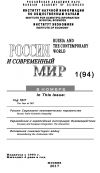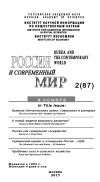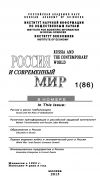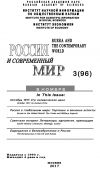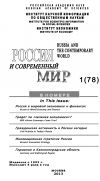Текст книги "Россия и современный мир №4 / 2017"
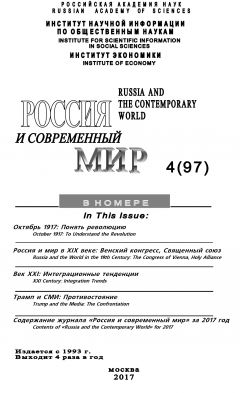
Автор книги: Юрий Игрицкий
Жанр: Журналы, Периодические издания
сообщить о неприемлемом содержимом
Текущая страница: 10 (всего у книги 22 страниц)
In 1815 things changed, as the Hundred Days gave new impetus to the campaign against the Atlantic trade in slaves. Almost immediately on his return to Paris, on 29 March 1815, Napoleon issued a decree from the Tuileries abolishing the slave trade. From that date, it stated, no expeditions would be authorised either from French ports or from those of France’s colonies. And though slavers who had already left were authorised to complete their voyages and sell their cargoes, they would be the last. In future no blacks could be taken legally into France’s colonies for sale, whether by French ships or by others4040
Imperial decree abolishing the slave trade, 29 March 1815 [2, p. 345].
[Закрыть]. The terms seemed incontrovertible and appeared to indicate a remarkable change of heart by the Emperor. Yet Napoleon was no abolitionist; he had already restored slavery to other French Caribbean possessions, in Guadeloupe and Guyane, and his apparent conversion to the cause of abolition must be understood as a political manoeuvre rather than a gesture of principle, part of an attempt to change his image and reinvent himself as a man of the people in the tradition of the French Revolution [16, p. 44]. Besides, he showed little interest in enforcing abolition, and within a week of the decree’s promulgation a slave-ship from Nantes was already on the high seas, sailing with apparent impunity to the coast of West Africa. But for British abolitionists it seemed propitious. They might not trust Napoleon to deliver on his promise. They might equally work for his overthrow by voting military credits for the Allied armies. But the moment had a crucial symbolic significance for them. France had joined Britain in abolishing the trade, something they had been demanding since 1807, and their main concern now turned to the second restoration that was to follow. Could Louis XVIII be trusted to outlaw the traffic? Would the Bourbons respect legislation that had been passed by the Usurper? In Vienna the British government signed a proposed clause for the final treaty that promised immediate abolition north of the Equator. But Talleyrand was already taking steps to protect his King’s freedom of manoeuvre, inserting a revised wording whereby Louis would give his consent only after he was assured that «the actual state and needs of his colonies … permitted him to do so». His aim was purely diplomatic: as he assured Louis, «we ceded nothing and nevertheless the English are content with us» [20, p. 53].
Following Waterloo and Napoleon’s second abdication, Britain’s diplomatic hand was considerably strengthened, while abolitionists at Westminster sensed that their moment had come. In the peace negotiations that opened in Paris Britain sought to impose on the French an undertaking to abolish the trade and an acceptance of Britain’s droit de visite on French commercial shipping. This would prove difficult to enforce, of course, and various compromises were agreed which meant that abolition would not take place right away, to allow French ports and French merchants a period of adjustment, but the deal satisfied Wilberforce and the abolitionist lobby in the British Parliament. For France it opened a period of much-reduced profits, with merchants and ships’ captains forced into an illicit trade that was policed at sea by the British, and soon also the French, navies, and was exposed to both moral obloquy and criminal prosecution. But the French were lax in enforcing the law, and before 1831 – when an Anglo-French agreement was finally signed -arrests were comparatively rare [5, p. 430]. And it did not kill the French triangular trade. For the British abolitionists this was a bitter disappointment. The French, they felt, had been allowed to regain Martinique and Guadeloupe without being held to a clear abolitionist agenda. Others continued to resist, or to seek a prolongation of their trade [9, p. 343–358]. Spain and Portugal prevaricated and imposed their own conditions, so that south of the Equator the Congress of Vienna had little impact.
Castlereagh and the British delegation did not leave Vienna empty-handed: it was just that most of what they achieved consisted of promises for the future, of statements of intent rather than clear political commitments. In a recent study of the Congress settlement David King tries to portray this achievement in as positive a light as possible, given that the diplomats and political leaders present had more pressing matters to settle with regard to the balance of power on the Continent. «On February 8, 1815, just days before his expected departure», he writes, «Castlereagh could finally point to some success», when the Great Powers issued a joint declaration condemning the slave trade in seemingly unequivocal terms, describing it as «repugnant to the principles of humanity and universal morality». They further agreed in the importance of ending a scourge that had so long «desolated Africa, degraded Europe and afflicted humanity», though there was no clear commitment as to quite when that would happen. The slave trade should be abolished as soon as possible; but only the Dutch could be pressurized into immediate abolition. France promised to do so in five years, Spain and Portugal agreed on eight years. Yet it was a start, and Britain took some satisfaction from it: human rights, for the first time, had been made a subject of a peace conference, and it looked as if anti-slavery had become a moral force that was difficult to counter [21, p. 217]. Indeed, Wilberforce admitted privately, after meeting Castlereagh on his return from Vienna, that «I believe all done that could be done» [20, p. 54].
But if slaving could not be policed, then that achievement was only relative, and arguments over the right to board suspect vessels dragged on. Castlereagh was not wholly averse to some sort of compromise here, since he was well aware of the sensitivities the policy could cause. With the Americans – who had already abandoned the slave trade – that compromise was easier to achieve: in 1817 he offered the new American ambassador to London, Richard Rush, «a reciprocal right of search for slaves, and a limited number of the armed vessels of each of the maritime states to be empowered to search» [1, p. 446]. But France presented the British government with an altogether more difficult problem. Louis XVIII had domestic concerns to address, especially in the merchant ports of the Atlantic coast, and he could not be seen to be giving in to British pressure while an army of occupation remained on French territory, as this would give the impression that Britain was simply dictating terms to him. Castlereagh had to make do with statements of intent which he could present to the British Parliament as a more limited diplomatic triumph. A further conference called for 1816 in London also failed to produce binding agreements. But the assurances given by the French at least had the result of diverting the main thrust of abolitionist attack from France to Spain, which refused to take any action until 1823, and then only north of the Equator. A series of bilateral treaties with Holland, Spain and Portugal placed limits on their liberty to trade (in the cases of Spain and Portugal, Britain paid out £700,000 each in compensation [1, p. 447]). But Britain’s right to stop ships which were suspected of slaving remained contested and had no basis in international law until it was finally recognised by an agreement signed between Britain and Louis-Philippe’s France in 1831.
How effective was it? Ships were rarely stopped on the high seas, or in mid-Atlantic. Rather, searches were concentrated around the African coast, at those points like the Bight of Benin or the Bight of Biafra that were the centres of trade with African kings and slavers; in the waters off the French Caribbean islands of Guadeloupe and Martinique; or on the approaches to Cuba, where many French planters from Saint-Domingue had fled to resume their slave economy in Santiago de Cuba and its hinterland, and where, in the east of the island, they formed an important ethnic community [27; 22]. Off West Africa the British had the added advantage of a string of forts, whereas the French had only one, on Gorée [13, p. 227]. Here a number of French slave ships were stopped and arrested, and the volume of French slaving diminished as a consequence. But the trade was not eliminated; rather, the presence of British patrols off traditional slaving regions of West Africa, like Seregambia and the Gold Coast, had the effect of pushing the slave ships further south, to West Central Africa and the Bight of Biafra. From there ships of all the European slaving nations continued shipping Africans to the Caribbean; it was just that Cuba had replaced Saint-Domingue as their favoured slave market. In the twenty years to 1835 nearly 40,000 captives were shipped from the Bight of Biafra into slavery in the Americas [24, p. 184]. In this context Britain’s supposed victory on the issue at Vienna and in the bilateral treaties that followed must have seemed insignificant.
Many merchants in Nantes and Bordeaux sought to resume slaving as soon as the years of war and blockade were over. Some tried to conceal the identity of their vessels, or sailed back into foreign ports like Hamburg or Antwerp to avoid the waiting warships [6, p. 97]. Others sailed with false papers. Nantes – a port city whose wealth before the Revolution had been made through the slave trade – found it especially difficult to adapt to the new world order, and many businesses now sought to recoup the losses of the war years by returning to the trade in black ebony. As early as January 1815, we know of three ships – the Cultivateur, the Bonne-Mère, and the Sénégalaise – fitted out in Nantes, crewed with men from Brittany, from Nantes and Pornic, Lorient and Paimboeuf, which sailed for West Africa, loaded with silks and guns and all the usual accoutrements of the African trade. Their somewhat mixed fortunes reflect the precarious nature of the times. Of the three, only the Sénégalaise completed its voyage unimpeded. The Bonne-Mère was at anchor in Guadeloupe on 10 August 1815 when the island capitulated to the British; it was seized in the roads off Pointe-à-Pitre and treated by the British admiralty courts as an enemy ship, even though the war between France and Britain had ended nearly two months earlier at Waterloo [30, p. 155]. The Cultivateur was arguably even more unlucky as it in turn fell foul of British efforts to police the Atlantic. When it left Saint-Nazaire on 1 April it was respecting both French and British law at the time; and it also respected the restrictions that had been placed on African trading. But this did not prevent its being arrested by a British schooner at Bonny, or being taken back to Plymouth for trial. On 16 November the ship was finally released by the High Court of Admiralty, and an indemnity paid. It set out again for the coast of West Africa in May 1816 on a second slaving voyage [8; 11].
The numbers tell their own story. French involvement in the traite diminished as the hustling and interception increased, and more and more captains decided that the risk of capture was simply too great. But it cannot all be put down to the effect of British pressure. The loss of Saint-Domingue had greatly reduced the demand for slaves in the Caribbean, with the consequence that the economics of the slave trade was now less certain. And there is evidence that the moral campaign against slavery was having an effect, as abolitionist tracts were published in ever-greater numbers and English campaigners like Thomas Clarkson were more widely read in French. As alternative commercial opportunities were found – in the Levant, North Africa and the East Indies, for instance – the popularity of the African slave trade fell away, most particularly in ports along the Mediterranean littoral like Marseille. But during the Restoration the abolitionists could claim only a partial success. The illegal slave trade of Bordeaux and Nantes did not wither overnight. No comprehensive figures exist for slave voyages in these years, as they were necessarily clandestine, but such statistics as we do have are suggestive of a much wider flouting of the law. Between 1814 and 1826 Eric Saugera lists more than forty vessels leaving Bordeaux alone for the African coast, heading to Calabar, or Gorée, or Senegal – with one firm responsible for five different voyages [29, p. 361–362]. And French slave voyages were just the tip of a much larger iceberg. For the ships’ owners and their sea captains the risks were still worth taking. During the Restoration years some 3000 slave ships were still plying the Atlantic, most between West Africa and South America or the Caribbean. The abolitionists in London had relatively little to cheer about: indeed, Serge Daget concludes rather bleakly that «all the conditions of the traditional slave trade are still present in this period, scarcely diminished by illegality and repression» [7, p. 90].
Библиография
1. Bew, J. Castlereagh: A Life. London: Oxford University Press, 2012. 752 p.
2. Branda, P., Lentz, Th. Napoléon, l’esclavage et les colonies. Paris: Fayard, 2006. 359 p.
3. Brian, E. Vick. The Congress of Vienna: Power and Politics after Napoleon. Cambridge, MA: Harvard University Press, 2014. 436 p.
4. Clarkson, Th. Le Cri des Africains contre les Européens, leurs oppresseurs, ou coup d'oeil sur le commerce homicide appelé traite des Noirs / French translation. London, 1821.
5. Daget, S. British Repression of the Illegal French Slave Trade: some considerations // The Uncommon Market: Essays in the Economic History of the Atlantic Slave Trade. New York, 1979. P. 419–442.
6. Daget, S. La répression de la traite des Noirs au dix-neuvième siècle. L’action des croisières françaises sur les côtes occidentales de l’Afrique, 1817–1850. Paris: Karthala, 1997. 632 p.
7. Daget, S. Long cours et négriers nantais du trafic illégal, 1814–1833 // La traite des noirs par l’Atlantique: nouvelles approches. Paris: Société française d'Histoire d'Outre-Mer et P. Geuthner, 1976. P. 90–134.
8. Daget, S. Répertoire des expéditions négrières françaises à la traite illégale, 1814–1850. Nantes: Centre de recherches sur l'histoire du monde atlantique, Université de Nantes, 1988. 603 p.
9. Daget, S. Tactiques, stratégies et effets du droit de visite // Actes du Colloque international sur la traite des Noirs. Nantes, 1985. Vol. 2. P. 343–358.
10. Drescher, S. Capitalism and Abolition: Values and forces in Britain, 1783–1814. Liverpool: in Roger Anstey and P.E.H. Hair, 1976.
11. Drescher, S. Whose Abolition? Popular Pressure and the Ending of the British Slave Trade // Past and Present. 1994. Vol. 143. P. 136–166.
12. Fladeland, B. «Abolitionist Pressures on the Concert of Europe, 1814–1822» // Journal of Modern History. 1966. Vol. 38. N 4. P. 355–373.
13. Gaston, M. Nantes au dix-huitième siècle: l’ère des négriers. Paris, 1931.
14. Hansard, T.C. The Parliamentary Debates from the Year 1803 to the Present Time. London, 1814. Vol. 27.
15. Hansard, T.C. The Parliamentary Debates from the Year 1803 to the Present Time. London, 1815. Vol. 30.
16. Hazareesingh, S. The Legend of Napoleon. London: Granta Books, 2004. 336 p.
17. Helfman, T. The Court of Vice Admiralty at Sierra Leone and the Abolition of the West African Slave Trade // The Yale Law Journal. 2006. Vol. 115. N 5. P. 1122–1156.
18. Henry Christophe and Thomas Clarkson: A Correspondence. Berkeley: CA, 1952. 287 p.
19. Journal of the House of Lords. London: Originally published by His Majesty's Stationery Office, [n.d.]. Vol. 63. 1830–1831.
20. Kielstra, P.M. The Politics of Slave Trade Suppression in Britain and France, 1814–48: Diplomacy, Morality and Economics. Basingstoke, 2000.
21. King, D. Vienna, 1814: How the Conquerors of Napoleon made Love, War and Peace at the Congress of Vienna. New York: Three Rivers Press, 2008. 448 p.
22. Lamore, M.E.O., Monnar, M.T.F. Formation d’une ville caraïbe: Urbanisme et architecture à Santiago de Cuba. Pessac, Presses Universitaires de Bordeaux, 2011, 510 p.
23. Le combat pour la liberté des Noirs dans le Journal de la Société de la Morale Chrétienne / Présentation de Marie-Laure Aurenche. Paris: L’Harmattan, 2011. Vol. 1–2.
24. Moráguez, O.G. The African origins of slaves arriving in Cuba, 1789–1865’ // Extending the Frontiers: Essays on the New Transatlantic Slave Database. New Haven, CT, 2008.
25. Nelson, B.H. The Slave Trade as a Factor in British Foreign Policy, 1815–1862 // Journal of Negro History. 1942. Vol. 27. N 2. P. 192–209.
26. Reich, J. The Slave Trade at the Congress of Vienna – A Study in English Public Opinion // The Journal of Negro History. 1968. Vol. 53. N 2. P. 129–143.
27. Renault, A. D’une île rebelle à une île fidèle: Les Français de Santiago-de-Cuba (1791–1825). Mont-Saint-Aignan: Publications des Universités de Rouen et du Havre, 2012. 528 p.
28. Ryan, M. The price of legitimacy in humanitarian intervention: Britain, the right of search, and the abolition of the West Indian slave trade, 1807–1867. Cambridge: Cambridge University Press, 2011. 408 p.
29. Saugera, E. Bordeaux, port négrier: Chronologie, économie, idéologie, XVIIe siècle – XIXe siècle. Paris: Karthala, 1995. 384 p.
30. Saugera, E. La Bonne-Mère, navire négrier nantais, 1802–1815. Paris; Nantes: Karthala, 2012. 196 p.
31. Sherwood, M. The British Illegal Slave trade, 1808–1830 // Journal for Eighteenth-Century Studies. 2008. Vol. 31. N 2. P. 293–305.
32. Walvin, J. The Rise of British Popular Sentiment for Abolition, 1787–1832. Anti-Slavery, Religion and Reform: Essays in emory of Roger Anstey. Folkestone: eds. Christina Bolt and Seymour Drescher, 1980.
33. Ward, W.E.F. The Royal Navy and the Slavers: The Suppression of the Atlantic Slave Trade. London: Allen & Unwin, 1969. 246 p.
34. Wilson, E.G. Thomas Clarkson: A Biography. Basingstoke, 1989.
35. Yacou, A. Essor des plantations et subversion antiesclavagiste à Cuba (1791–1845). Paris: Karthala, 2010. 624 p.
References
Bew John. Castlereagh: A Life. London: Oxford University Press, 2012. 752 p.
Branda Pierre, Lentz Thierry. Napoléon, l’esclavage et les colonies. Paris: Fayard,, 2006. 359 p.
Brian E. Vick. The Congress of Vienna: Power and Politics after Napoleon. Cambridge, MA: Harvard University Press, 2014. 436 p.
Clarkson Thomas. Le Cri des Africains contre les Européens, leurs oppresseurs, ou coup d'oeil sur le commerce homicide appelé traite des Noirs / French translation. London, 1821.
Daget Serge. British Repression of the Illegal French Slave Trade: Some considerations // The Uncommon Market: Essays in the Economic History of the Atlantic Slave Trade. New York, 1979. P. 419–442.
Daget Serge. La répression de la traite des Noirs au dix-neuvième siècle. L’action des croisières françaises sur les côtes occidentales de l’Afrique, 1817–1850. Paris: Karthala, 1997. 632 p.
Daget Serge. Long cours et négriers nantais du trafic illégal, 1814–1833 // La traite des noirs par l’Atlantique: Nouvelles approches. Paris: Société française d'Histoire d'Outre-Mer et P. Geuthner, 1976. P. 90–134.
Daget Serge. Répertoire des expéditions négrières françaises à la traite illégale, 1814–1850. Nantes: Centre de recherches sur l'histoire du monde atlantique, Université de Nantes, 1988. 603 p.
Daget Serge. Tactiques, stratégies et effets du droit de visite // Actes du Colloque international sur la traite des Noirs. Nantes, 1985. Vol. 2. P. 343–358.
Drescher Seymour. Capitalism and Abolition: Values and forces in Britain, 1783–1814. Liverpool: in Roger Anstey and P.E.H. Hair, 1976.
Drescher Seymour. Whose Abolition? Popular Pressure and the Ending of the British Slave Trade // Past and Present. 1994. Vol. 143. P. 136–166.
Fladeland Betty. «Abolitionist Pressures on the Concert of Europe, 1814–1822» // Journal of Modern History. 1966. Vol. 38. N 4. P. 355–373.
Gaston Martin. Nantes au dix-huitième siècle: l’ère des négriers. Paris, 1931.
Hansard T.C. The Parliamentary Debates from the Year 1803 to the Present Time. London, 1814. Vol. 27.
Hansard T.C. The Parliamentary Debates from the Year 1803 to the Present Time. London, 1815. Vol. 30.
Hazareesingh Sudhir. The Legend of Napoleon. London: Granta Books, 2004. 336 p.
Helfman Tara. The Court of Vice Admiralty at Sierra Leone and the Abolition of the West African Slave Trade // The Yale Law Journal. 2006. Vol. 115. N 5. P. 1122–1156.
Henry Christophe and Thomas Clarkson: A Correspondence. Berkeley: CA, 1952. 287 p.
Journal of the House of Lords. London: Originally published by His Majesty's Stationery Office, [n.d.]. Vol. 63. 1830–1831.
Kielstra Paul Michael. The Politics of Slave Trade Suppression in Britain and France, 1814–48: Diplomacy, Morality and Economics. Basingstoke, 2000.
King David. Vienna, 1814: How the Conquerors of Napoleon made Love, War and Peace at the Congress of Vienna. New York: Three Rivers Press, 2008. 448 p.
Lamore Maria Elena Orozco, Monnar Maria Teresa Fleitas. Formation d’une ville caraïbe: Urbanisme et architecture à Santiago de Cuba. Pessac, Presses Universitaires de Bordeaux, 2011, 510 p.
Le combat pour la liberté des Noirs dans le Journal de la Société de la Morale Chrétienne / Présentation de Marie-Laure Aurenche. Paris: L’Harmattan, 2011. Vol. 1–2.
Moráguez Oscar Grandío. The African origins of slaves arriving in Cuba, 1789–1865’ // Extending the Frontiers: Essays on the New Transatlantic Slave Database. New Haven, CT, 2008.
Nelson Bernard H. The Slave Trade as a Factor in British Foreign Policy, 1815–1862’ // Journal of Negro History. 1942. Vol. 27. N 2. P. 192–209.
Reich Jerome. The Slave Trade at the Congress of Vienna – A Study in English Public Opinion // The Journal of Negro History. 1968. Vol. 53. N 2. P. 129–143.
Renault Agnès. D’une île rebelle à une île fidèle: les Français de Santiago-de-Cuba (1791–1825). Mont-Saint-Aignan: Publications des Universités de Rouen et du Havre, 2012. 528 p.
Ryan Maeve. The price of legitimacy in humanitarian intervention: Britain, the right of search, and the abolition of the West Indian slave trade, 1807–1867. Cambridge: Cambridge University Press, 2011. 408 p.
Saugera Eric. Bordeaux port négrier: chronologie, économie, idéologie, XVIIe siècle – XIXe siècle. Paris: Karthala, 1995. 384 p.
Saugera Eric. La Bonne-Mère, navire négrier nantais, 1802–1815. Paris; Nantes: Karthala, 2012. 196 p.
Sherwood Marika. The British Illegal Slave trade, 1808–1830 // Journal for Eighteenth-Century Studies. 2008. Vol. 31. N 2. P. 293–305.
Walvin James. The Rise of British Popular Sentiment for Abolition, 1787–1832. Anti-Slavery, Religion and Reform: Essays in emory of Roger Anstey. Folkestone: eds. Christina Bolt and Seymour Drescher, 1980.
William Ernest Frank Ward. The Royal Navy and the Slavers: The Suppression of the Atlantic Slave Trade. London: Allen & Unwin, 1969. 246 p.
Wilson Ellen Gibson. Thomas Clarkson: A Biography. Basingstoke, 1989.
Yacou Alain. Essor des plantations et subversion antiesclavagiste à Cuba (1791–1845). Paris: Karthala, 2010. 624 p.
Правообладателям!
Это произведение, предположительно, находится в статусе 'public domain'. Если это не так и размещение материала нарушает чьи-либо права, то сообщите нам об этом.

